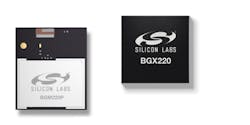Download this article in PDF format.
Bluetooth (BT) has been with us for over 20 years now. It’s become the largest volume wireless technology in use today, with industrial IoT and widespread consumer adoption keeping BT ahead of all other wireless standards. Research indicates that 4 billion Bluetooth units were shipped in 2019, and forecasts reveal that 5.4 billion units are expected to ship in 2023—an increase of 26%.
BT’s popularity is due to its reliability, flexibility, and the fact that it’s so easy to use. On top of that, the Bluetooth Special Interest Group (SIG) continues to develop, improve, and fine-tune the standard, making it even better.
However, Bluetooth also has a key drawback: Some RF and wireless knowledge, experience, and design capability are generally needed to put together your own BT-enabled product, starting with the radio IC. That wireless background often isn’t found in most engineers today. It’s not that the engineer can’t complete a from-scratch BT design, but the learning curve is steep, and the extra design time can break the budget and drag out the time to market.
The solution to all this, of course, is the Bluetooth module.
Sponsored Resources:
- Highly integrated, scalable connectivity solution
- BGX220P Pre-Programmed Bluetooth® Modules
- BGM220 Bluetooth™ Modules | First Look
The Benefits of Bluetooth Modules
A Bluetooth module is a complete radio in a small package that can be designed into another product. Just add dc power, maybe an external antenna if one isn’t already fully integrated, and any inputs like sensors that generate the data to be communicated. You needn’t be a PhD RF and microwave guru, know Maxwell’s equations, or antenna design to use a module. Just buy it, package it with your host product, write some firmware, and voilà…a Bluetooth-enabled device.
The module eliminates a great deal of design time with things like PCB layout for the Bluetooth IC and other analog signals such as sensor inputs that need conditioning and digitizing, as well as the usual mechanical packaging challenge. You can focus on your main objective while feeling confident that the Bluetooth wireless capability has been handled.
Keep in mind that if you do attempt to make a radio, Bluetooth or other, some firmware development will probably be required to make the radio work in your application. Moreover, you must have your final product tested and certified by the Federal Communications Commission (FCC). The tests are generally outside the knowledge of most engineers, not to mention the high-priced test gear needed. The solution is to hire an official testing lab to perform the testing and certification, which adds thousands of dollars to the budget. Using a module eliminates this need, process, and cost.
But just so you know, a plug-and-play module may cost more than your own special design. However, you will save design time, testing, and other costs to offset that when doing your own cost-benefit analysis for the module option.
Next-Generation Bluetooth Modules
Bluetooth modules have been available for years, morphing from large clunky boxes into today’s small IC-like modules. A good example of the latest modules is Silicon Labs’ BGX220. It’s a pre-programmed module designed for cable replacement. No firmware development is required. The module leverages the Bluetooth Low Energy (BLE) 5 standard, which can achieve a maximum data rate of 2 Mb/s.
Using the BGX220, embedded systems are able to communicate via a BLE link to other BGX220 modules as well as to devices like a smartphone. I2C, UART, and GPIO interfaces provide the connections.
Other BLE modules include the BGM220S and BGM220P.The BGM220S is a super-compact, low-cost, 6- × 6-mm system-in-package (SiP) module that can deliver up to a 10-year battery lifetime on a single coin cell. The BGM220P is a larger module on a 13- × 15- × 2.2-mm PCB. With its Bluetooth 5.2 +8-dBm transmit power and receiver sensitivity of −106.7 dBm, the link budget provides greater range.
Among their other features are:
- Low power consumption: 4.8 mA with 0-dBm transmit power and 4.8 mA on receive.
- Great security: AES128/256, SHA-1, SHA-2 (256-bit) with ECC (up to 256-bit)
- A 12-bit ADC with 16 input channels
- A wake-on radio RF sense capability
- Built-in temperature sensor
And just as a reminder, these new modules support the BLE Mesh configuration and direction-finding ability using angle-of-arrival (AoA), and angle-of-departure (AoD) techniques.
As for applications, the possibilities are just too vast to cover here. They are whatever you can imagine. With low cost IC-size modules, you can put BLE in just about any product.
Sponsored Resources:


